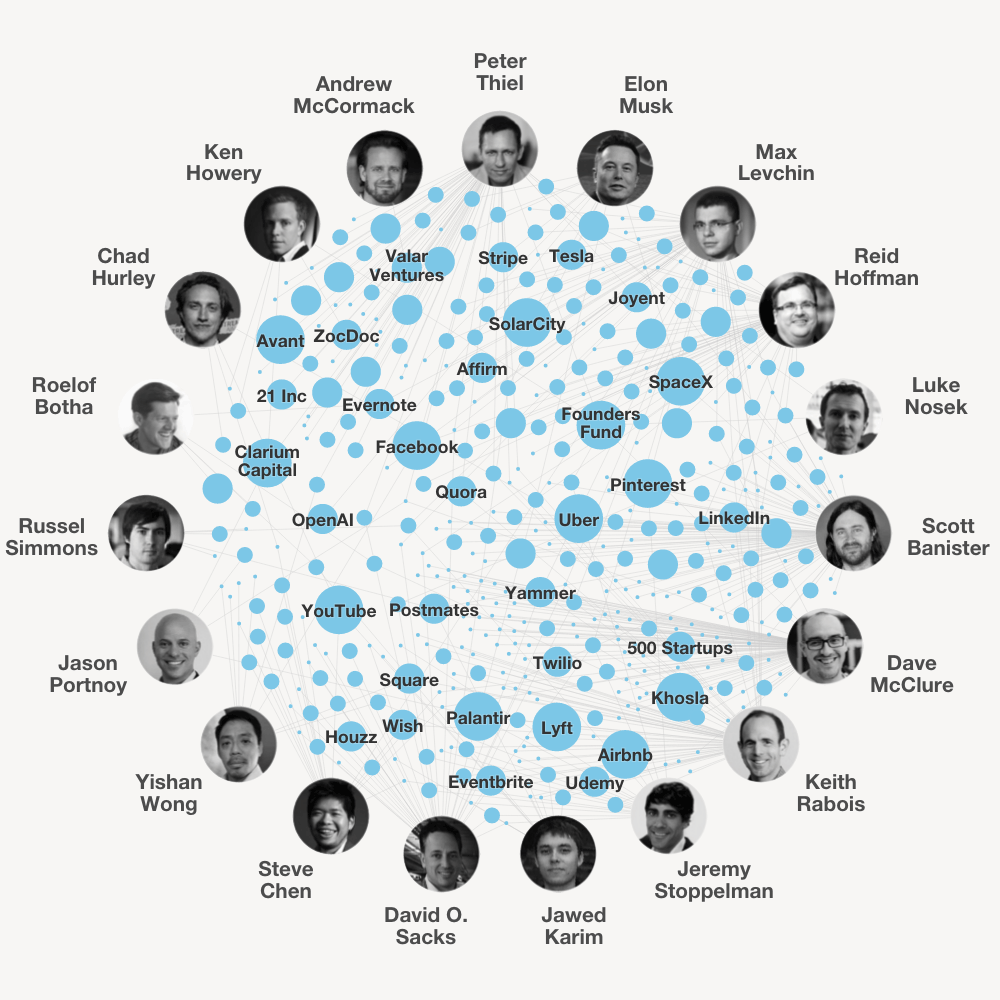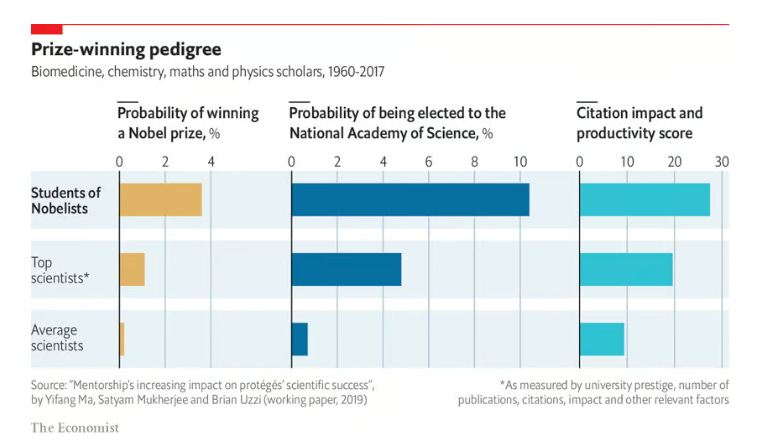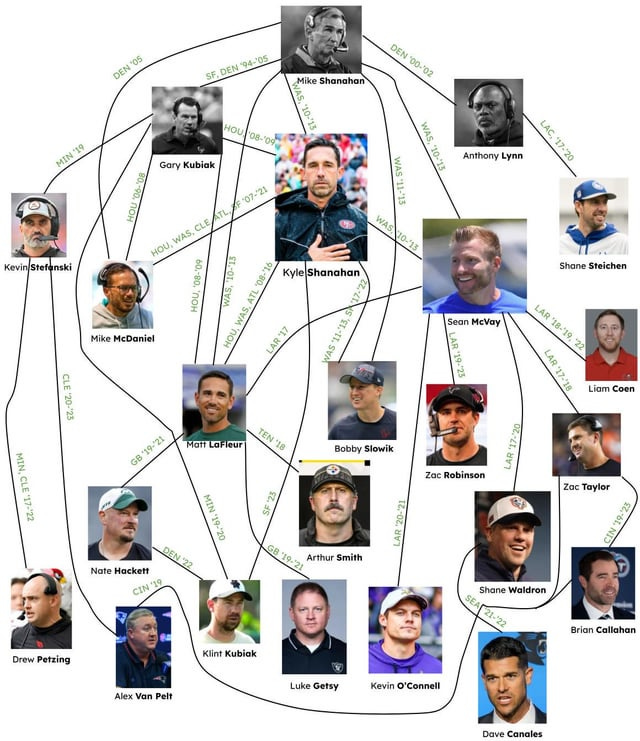“Smart people know smart people.”
This insight has proven to be the most reliable truth I've encountered as an early-stage investor.
After meeting thousands of founders, the pattern is clear: exceptional talent gravitates toward other exceptional talent. The best founders don't just build products - they build talent vortexes that reshape industries.
From PayPal’s legendary “mafia” to the Shanahan coaching tree in the NFL, these talent clusters have produced disproportionate impact across every domain. The world’s most successful companies, scientific breakthroughs, and championship teams all emerge from the same phenomenon: small groups of extraordinary people who found each other.
Talent clusters are all around us
Tech mafias
The PayPal mafia is perhaps the most famous of the talent mafias. Alumni of PayPal went on to build or run some of the most iconic companies in venture capital, social media, fintech, automotive, and more.

Today’s PayPal mafia may very well be the ‘OpenAI’ mafia — with spinouts leading to companies like Anthropic, Perplexity, Cleanlab, Adept, Safe Super Intelligence, and others. We’ve also seen members of the OpenAI team join prominent investment firms like Fraser Kelton at Spark or Peter Deng at Felicis.
But beyond technology and startups, we also see this clustering behavior with top talent in other domains.
Mafias in the rest of the world
One place where we see talent clustering outside of tech is science. The students of Nobel Prize winners are much more likely than average to win a Nobel Prize themselves.
The chances of winning are still quite low, but they’re many, many times more likely to win this prestigious award than the average scientist.

In sports, NFL head coaches also tend to cluster in “coaching trees” based on a singular influential coach they’ve worked under. There are a handful of these trees that have produced many successful coaches.

It’s clear that whatever you want to call them — talent mafias, clusters, or vortexes — they are very real and they are widespread.
So what exactly makes these talent clusters form? And what ensures their success once they’ve come together?
1/ It starts at the top
Talent clusters start with exceptional leaders who have two essential attributes.
1. Talent recognition
There’s a saying attributed to Max Levchin that is:
“As hire As, Bs hire Cs. So the first B you hire takes the company down”
A talent cluster starts with the top. If the founder, coach, or leader isn’t excellent, they won’t surround themselves with excellence.
I also endorse the view that you can only really assess people less talented than you with any granularity. For people more talented than you, you lack the experience and skills to discern their abilities a level of precision.
On a recent podcast with Jack Altman, Shaun Maguire said:
If you ask a 1,000 rated chess player [to watch multiple games and guess the rating of the player they’re watching]…they can't do it. Like they can't tell the difference of the 2,600 rated player versus 2,200 rated player.
Whereas if you do it the other direction, if you ask the 2,600 rated player to judge a 2,200 rated game, an 1,800 game, a 1,400 rated game, a 1,000 rated game, they can watch 10 moves and they can basically tell you the [rating] of those people.
It takes someone exceptional to discern the difference between good, great, and elite talent.
2. Intensity
Yishan Wong (early PayPal) observed that PayPal's magic wasn't just their talent but "the level of intensity from the top:
"In general, as I begin to survey more startups, I find that the talent level at PayPal is not uncommon for a Silicon Valley startup, but the differentiating factor may have been the level of intensity from the top: both Peter Thiel and Max Levchin were extremely intense people - hyper-competitive, hard-working, and unwilling to accept defeat. I think this sort of leadership is what pushes the "standard" talented team to be able to do great things and, subsequently, contributes to producing a wellspring of later achievements."
This intensity pushed even ordinary team members to extraordinary achievements.
Always start with the leader when spotting talent clusters. If you see exceptional talent there, you're likely witnessing a talent cluster.
2/ There’s a distinct DNA
Every powerful talent cluster develops a unique "DNA" — a distinctive approach that becomes their signature. This isn't just culture; it's a worldview that defines their work.
Without a clear top 1% capability, you're unlikely to find a true talent cluster.
Palantir: The Forward Deployed Model
Palantir developed a distinctive approach with their Forward Deployed Engineer (FDE) model. Nabeel Qureshi (former Palantir) explains:
Being a successful FDE required an unusual sensitivity to social context – what you really had to do was partner with your corporate (or government) counterparts at the highest level and gain their trust, which often required playing political games….If you didn’t know all this, you were unlikely to succeed in a customer environment. Which meant you were unlikely to integrate customer data or get people to use your software. Which meant failure.
This is one reason why former FDEs tend to be great founders…Good founders have an instinct for reading rooms, group dynamics, and power. This isn’t usually talked about, but it’s critical: founding a successful company is about taking part in negotiation after negotiation after negotiation, and winning (on net).
The combination of technical expertise and high social intelligence created a uniquely valuable skillset that former Palantir employees carried into new ventures.
Kyle Shanahan: Adaptive and complex offensive scheme
In football, Kyle Shanahan created a distinctive offensive scheme characterized by adaptability and positional versatility. His influence is immediately recognizable in teams led by his former assistants like Sean McVay (Rams) and Mike McDaniel (Dolphins).
One NFL General Manager noted:
An [NFL General Manager] I texted pointed to the [Kyle] Shanahan pedigree, saying, “I looked last week, and four of the top eight offenses had coaches from that group. Talent, plus that scheme, is tough to stop.”
This signature style becomes the DNA that members of the talent cluster carry with them, propagating excellence across organizations.
3/ They become a self-fulfilling prophecy
Once talent clusters are formed, they create unstoppable virtuous cycles of success.
1. The network becomes your competitive advantage
In Silicon Valley, membership in a talent cluster is currency. When PayPal's Roelof Botha joined Sequoia Capital, he backed YouTube, founded by fellow PayPal alum Chad Hurley. This pattern repeats endlessly, creating an invisible support system that outsiders simply can't access.
At least in Silicon Valley, being part of a talent cluster gives you an unfair advantage in fundraising and building your team in your next endeavor.
2. The market is more likely to bet on someone with a successful track record.
“Nobody got fired for hiring IBM.”
This principle applies to any domain. Backing a Palantir founder or hiring a Shanahan assistant is always going to be seen as a safe bet. The talent cluster's reputation becomes a powerful form of risk reduction for investors, employers, and partners.
Being associated with a talent cluster gets you in the room while others may be left at the door.
3. Success opens the door to greater ambitions
Success compounds both financially and psychologically.
PayPal's exit gave Elon Musk the resources for Tesla, which in turn enabled SpaceX. Each success expanded his ambitions.
This pattern continues with Robinhood co-founder Baiju Bhatt, whose first success gave him the credibility to raise $50M for Aetherflux, his ambitious space venture.
Early wins have fueled our most ambitious second acts.
Closing thoughts
We live in a world where the value of hard skills is rapidly approaching zero. In a world where anyone can perform any task with a short prompt, who you know will matter more than what you know.
So, seek exceptional talent. Ask, “Who are the smartest people I know?”
Once you have your answer, ask yourself, “Why am I not working with them?”




